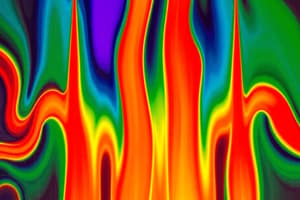Podcast
Questions and Answers
What is the effect of heating a gas or vapor on its molecules?
What is the effect of heating a gas or vapor on its molecules?
- The molecules bond together to form a solid.
- The molecules slow down and lose kinetic energy.
- The molecules speed up and gain kinetic energy. (correct)
- The molecules remain at the same speed but change direction.
What is internal energy?
What is internal energy?
- The energy stored in the chemical bonds of a substance.
- The energy released when a substance undergoes a chemical reaction.
- The energy associated with the motion of the object as a whole.
- The total energy of an object, including its kinetic and potential energy. (correct)
What two factors determine the temperature rise of an object when it is heated?
What two factors determine the temperature rise of an object when it is heated?
- The mass of the object and the amount of energy supplied.
- The amount of energy supplied and the substance the object is made from.
- The mass of the object and the substance the object is made from.
- All of the above. (correct)
What is the specific heat capacity of a substance?
What is the specific heat capacity of a substance?
Why does sand heat up faster than water?
Why does sand heat up faster than water?
In the inversion tube experiment, what is the source of the internal energy gain in the lead shot?
In the inversion tube experiment, what is the source of the internal energy gain in the lead shot?
In the inversion tube experiment, what is the relationship between the gravitational potential energy loss and the internal energy gain of the lead shot?
In the inversion tube experiment, what is the relationship between the gravitational potential energy loss and the internal energy gain of the lead shot?
What is the formula for calculating the specific heat capacity (c) of the lead shot in the inversion tube experiment?
What is the formula for calculating the specific heat capacity (c) of the lead shot in the inversion tube experiment?
Which of the following is NOT an example of convection?
Which of the following is NOT an example of convection?
Why is a metal a better conductor of heat than a non-metal?
Why is a metal a better conductor of heat than a non-metal?
In what way does the density of a fluid affect its ability to transfer heat by convection?
In what way does the density of a fluid affect its ability to transfer heat by convection?
Which of the following is essential for the safe use of a gas fire?
Which of the following is essential for the safe use of a gas fire?
Which of the following is a FALSE statement about heat transfer by conduction?
Which of the following is a FALSE statement about heat transfer by conduction?
Which of the following scenarios would lead to the most efficient heat transfer by convection?
Which of the following scenarios would lead to the most efficient heat transfer by convection?
Why is it important to ensure that a hot air balloon is constantly heated?
Why is it important to ensure that a hot air balloon is constantly heated?
Which of the following statements correctly describes the relationship between thermal conductivity (K) and U-value?
Which of the following statements correctly describes the relationship between thermal conductivity (K) and U-value?
What is the relationship between work done on a system and the change in internal energy of the system?
What is the relationship between work done on a system and the change in internal energy of the system?
Which of the following best describes the motion of molecules in a solid?
Which of the following best describes the motion of molecules in a solid?
How does the internal energy of a solid change when it melts?
How does the internal energy of a solid change when it melts?
Which of the following statements accurately describes the relationship between temperature and the motion of molecules in a gas?
Which of the following statements accurately describes the relationship between temperature and the motion of molecules in a gas?
What is the change in the internal energy of a system if 100 Joules of heat is added to the system and 50 Joules of work is done by the system?
What is the change in the internal energy of a system if 100 Joules of heat is added to the system and 50 Joules of work is done by the system?
What is the relationship between the internal energy of a system and the temperature of the system?
What is the relationship between the internal energy of a system and the temperature of the system?
Which of the following is a correct statement about the first law of thermodynamics?
Which of the following is a correct statement about the first law of thermodynamics?
If a system absorbs heat while doing work, what can be concluded about the change in internal energy of the system?
If a system absorbs heat while doing work, what can be concluded about the change in internal energy of the system?
What type of radiation does every object emit due to its temperature?
What type of radiation does every object emit due to its temperature?
Which type of surface absorbs thermal radiation most effectively?
Which type of surface absorbs thermal radiation most effectively?
What is a black body in the context of radiation?
What is a black body in the context of radiation?
What is the primary factor that the rate of energy loss from a building can be reduced by?
What is the primary factor that the rate of energy loss from a building can be reduced by?
What does the U-value indicate in terms of insulation?
What does the U-value indicate in terms of insulation?
How is the energy transfer rate calculated with a temperature difference across insulation?
How is the energy transfer rate calculated with a temperature difference across insulation?
What is the U-value for a typical single-glazed window?
What is the U-value for a typical single-glazed window?
Which condition is NOT necessary for an object to be classified as a black body?
Which condition is NOT necessary for an object to be classified as a black body?
Which of the following is NOT a way to increase the internal energy of an object?
Which of the following is NOT a way to increase the internal energy of an object?
If a vehicle is moving at a constant speed, and its brakes are applied, what happens to the internal energy of the brake pads?
If a vehicle is moving at a constant speed, and its brakes are applied, what happens to the internal energy of the brake pads?
What is the primary reason for the transfer of energy by heating?
What is the primary reason for the transfer of energy by heating?
What is the most accurate statement about the internal energy of a lamp filament when it is switched on?
What is the most accurate statement about the internal energy of a lamp filament when it is switched on?
Which of the following is NOT a method of energy transfer by heating?
Which of the following is NOT a method of energy transfer by heating?
What is the relationship between the temperature of an object and its internal energy?
What is the relationship between the temperature of an object and its internal energy?
How does energy transfer by heating occur between two objects?
How does energy transfer by heating occur between two objects?
How does the electrical energy supplied to the metal block relate to the temperature rise?
How does the electrical energy supplied to the metal block relate to the temperature rise?
In the experiment to measure the specific heat capacity of a liquid, why is it important to assume no heat loss to the surroundings?
In the experiment to measure the specific heat capacity of a liquid, why is it important to assume no heat loss to the surroundings?
What is the purpose of the water or oil in the thermometer hole during the experiment?
What is the purpose of the water or oil in the thermometer hole during the experiment?
In the continuous flow heating system, what happens to the energy supplied to the copper coils?
In the continuous flow heating system, what happens to the energy supplied to the copper coils?
Why is there no mcΔΘ term for the copper coils in the equation for continuous flow heating?
Why is there no mcΔΘ term for the copper coils in the equation for continuous flow heating?
In the experiment to measure the specific heat capacity of a liquid using an insulated calorimeter, which of the following quantities are NOT required?
In the experiment to measure the specific heat capacity of a liquid using an insulated calorimeter, which of the following quantities are NOT required?
What is the main difference between measuring the specific heat capacity of a metal block and a liquid?
What is the main difference between measuring the specific heat capacity of a metal block and a liquid?
Which of the following would be the most likely reason for a discrepancy in the calculated specific heat capacity of a liquid?
Which of the following would be the most likely reason for a discrepancy in the calculated specific heat capacity of a liquid?
Flashcards
Energy transfer by heating
Energy transfer by heating
The process where energy moves from a hotter object to a cooler one.
Work done on an object
Work done on an object
The transfer of energy to an object by applying a force that moves it.
Internal energy
Internal energy
The total energy contained within an object due to molecular movement and positions.
Thermal energy
Thermal energy
Signup and view all the flashcards
Conduction
Conduction
Signup and view all the flashcards
Convection
Convection
Signup and view all the flashcards
Radiation
Radiation
Signup and view all the flashcards
Balancing internal energy
Balancing internal energy
Signup and view all the flashcards
First Law of Thermodynamics
First Law of Thermodynamics
Signup and view all the flashcards
Q (Heat Transfer)
Q (Heat Transfer)
Signup and view all the flashcards
W (Work Done)
W (Work Done)
Signup and view all the flashcards
Lowest Temperature Possible
Lowest Temperature Possible
Signup and view all the flashcards
Molecule
Molecule
Signup and view all the flashcards
Solid State
Solid State
Signup and view all the flashcards
Liquid State
Liquid State
Signup and view all the flashcards
Kinetic Energy
Kinetic Energy
Signup and view all the flashcards
Specific Heat Capacity
Specific Heat Capacity
Signup and view all the flashcards
Factors Affecting Temperature Rise
Factors Affecting Temperature Rise
Signup and view all the flashcards
Inversion Tube Experiment
Inversion Tube Experiment
Signup and view all the flashcards
Gravitational Potential Energy
Gravitational Potential Energy
Signup and view all the flashcards
Energy Transfer in Inversions
Energy Transfer in Inversions
Signup and view all the flashcards
Formula for Specific Heat Capacity
Formula for Specific Heat Capacity
Signup and view all the flashcards
Thermal Radiation
Thermal Radiation
Signup and view all the flashcards
Specific Heat Capacity of a Metal
Specific Heat Capacity of a Metal
Signup and view all the flashcards
Black Body
Black Body
Signup and view all the flashcards
Electrical Energy Supplied
Electrical Energy Supplied
Signup and view all the flashcards
Black Body Radiation
Black Body Radiation
Signup and view all the flashcards
Temperature Rise (ΔΘ)
Temperature Rise (ΔΘ)
Signup and view all the flashcards
Factors Affecting Radiation
Factors Affecting Radiation
Signup and view all the flashcards
U-Value
U-Value
Signup and view all the flashcards
Specific Heat Capacity of a Liquid
Specific Heat Capacity of a Liquid
Signup and view all the flashcards
Insulation Methods
Insulation Methods
Signup and view all the flashcards
Calorimeter
Calorimeter
Signup and view all the flashcards
Continuous Flow Heating
Continuous Flow Heating
Signup and view all the flashcards
Energy Transfer Equation
Energy Transfer Equation
Signup and view all the flashcards
Thermal Conductivity
Thermal Conductivity
Signup and view all the flashcards
Solar Heating Panel
Solar Heating Panel
Signup and view all the flashcards
Convection currents
Convection currents
Signup and view all the flashcards
Hot air balloon
Hot air balloon
Signup and view all the flashcards
Ocean currents
Ocean currents
Signup and view all the flashcards
Thermal conduction
Thermal conduction
Signup and view all the flashcards
Conduction electrons
Conduction electrons
Signup and view all the flashcards
Non-metal thermal conduction
Non-metal thermal conduction
Signup and view all the flashcards
Q/t = KA ΔΘ/L
Q/t = KA ΔΘ/L
Signup and view all the flashcards
Ventilation in gas fires
Ventilation in gas fires
Signup and view all the flashcards
Study Notes
Internal Energy and Temperature
- Internal energy is the total energy of the molecules in an object due to their individual movements and positions
- Thermal energy is a form of internal energy related to temperature
- Internal energy increases with heating or work done on an object
- If internal energy is constant, there is no energy transfer by heating or work balanced
First Law of Thermodynamics
- The change in internal energy of an object equals the total energy transferred due to work done on/by the object and heating
- ΔU = Q + W, where Q is energy transfer by heating and W is work done
Molecules
- Molecules are the smallest fundamental particles of a substance
- Atoms make up molecules
- Molecules are held together by forces due to electrical charges between atoms
- Molecules in a solid vibrate randomly at fixed positions
- Molecules in a liquid move randomly and freely
- Molecules in a gas move randomly at high speeds with much greater distance between each other
Temperature and Temperature Scales
- Temperature is a measure of the degree of hotness
- Hotter objects have more internal energy
- No overall energy transfer takes place if objects are at the same temperature (thermal equilibrium)
- Celsius scale is defined by ice point (0°C) and steam point (100°C)
- Absolute scale (Kelvin) is defined by absolute zero (0K) and triple point of water (273.16K)
- °C = K - 273.15
Specific Heat Capacity
- Specific heat capacity (c) is the energy needed to raise the temperature of unit mass of a substance by 1K without changing its state
- Measured in J kg⁻¹K⁻¹
- The energy needed to raise the temperature of a mass m of a substance from θ₁ to θ₂ is AQ = mc(θ₂ - θ₁)
Change of State
- Latent heat is the energy needed to change the state of a substance without changing its temperature
- Latent heat of fusion is the energy needed to melt a solid at its melting point
- Latent heat of vaporisation is the energy needed to vaporise a liquid at its boiling point
Energy Transfer by Heating
- Conduction is energy transfer via heating through a material
- Convection is transfer of energy via heating by movement of fluids
- Radiation is energy transfer via heating by electromagnetic waves
Studying That Suits You
Use AI to generate personalized quizzes and flashcards to suit your learning preferences.




